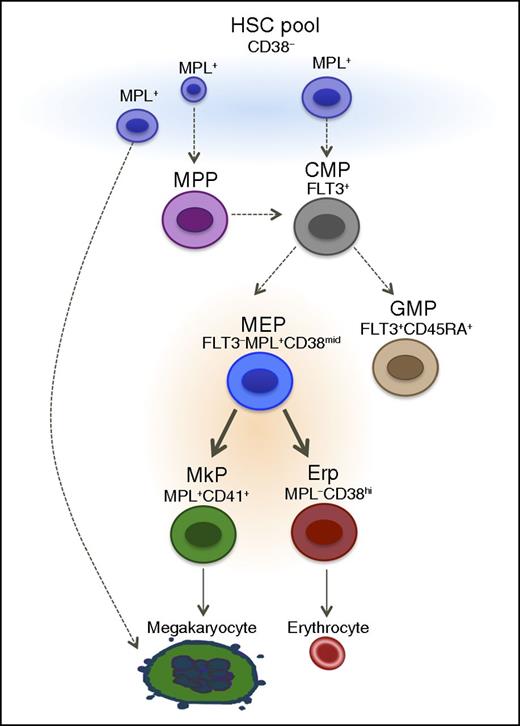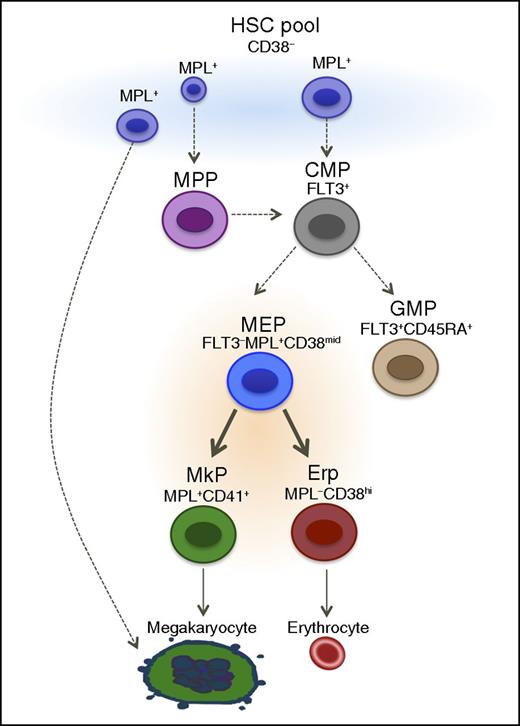In this issue of Blood, Sanada et al unveil a clever new refinement of in vitro colony forming unit assay, which allows them to follow differentiation of individual cells along both megakaryocytic and erythroid (E) pathways. With this assay system, they developed a new purification strategy for identification of primary functional human megakaryocyte/erythroid progenitor (MEP) cells. The possession of this enrichment technique should facilitate investigators into exploring the mechanisms of commitment of human hematopoietic stem cells (HSCs) into specific cell lineages.1
Model for human hematopoiesis proposed by the authors based on their findings. In the proposed model, mature cells such as Mks could be derived either by hierarchical and sequential differentiation of HSCs or derived directly from HSCs. See Figure 7 in the article by Sanada et al that begins on page 923.
Model for human hematopoiesis proposed by the authors based on their findings. In the proposed model, mature cells such as Mks could be derived either by hierarchical and sequential differentiation of HSCs or derived directly from HSCs. See Figure 7 in the article by Sanada et al that begins on page 923.
Since the discovery of mouse pluripotent HSCs by Till, McCulloch, and Siminovitch some 5 decades ago2 and the morphologic identification of human HSCs by Dicke et al a decade later,3 our understanding of how the various blood cell types are generated from the pluripotent stem cell has rapidly evolved.4-6 In the generally accepted classic model of hematopoiesis, hierarchical differentiation of the self-renewing pluripotent HSC leads to the production of stem cells with limited capacity for self-renewal (short-term HSC), which in turn gives rise to multipotent progenitors (MPPs) that can commit to either myeloid lineage (common myeloid progenitor) or lymphoid lineage (common lymphoid progenitor). New information is continually coming to light on the relative contributions of cytokines, growth factors, cell-cell interactions, transcriptional factor networks, and epigenetics in determining cell fate decisions at these different branch points.7,8 Major technical advances during the last decade, including the synthesis of a wide variety of new surface markers and the availability of high-speed flow sorters, now enable the isolation of highly enriched populations of hematopoietic cells at all stages of development. These advances, combined with single-cell culture technology and single-cell RNA sequencing, offer new hopes for a comprehensive understanding of cell fate determinants and the manner in which the progenitor cells at successive hierarchical states make a decision on the direction to take.
The study of Sanada et al displays the power of new methods, which they have put to use for isolating highly enriched populations of one of these intermediate cell populations, namely the bipotent MEPs that can give rise to both the megakaryocyte (Mk) and E lineages. By flow sorting of primary human bone marrow or granulocyte colony-stimulating factor mobilized peripheral blood cells, they separated the Lin−CD34+CD38midCD45RA−FLT3−MPL+CD36−CD41− cell population, which is highly enriched in bipotent MEPs. The success of these efforts relied on developing a novel dual-detection functional in vitro assay for single cells that enabled the single cell to differentiate into both Mk and E lineages. In the course of this work, they also developed strategies for enriching populations of primary human lineage-committed Mk progenitors (MkPs) and erythroid progenitors (ErPs). Comparative RNA expression analyses of MEP, MkP, and ErP populations revealed differential expression of MYB in these progenitor cells and showed that MYB plays a role in the MEP fate decision process.
Although the reported findings represent an impressive step toward an understanding of hematopoietic lineage commitment, a number of questions remain unanswered. Although the limited gene expression analysis presented imply a role for MYB in MEP lineage commitment, a more comprehensive gene expression analysis is needed to fully understand the network of genes and signaling pathways involved in MEP biology, and how their commitment to Mk and E lineages is determined. A recent study by Notta et al suggest that MEP is absent in adult humans and that Mks are derived directly from HSCs or MPPs.9 The reason for discrepancy in the 2 reported findings is not clear, although as suggested by the authors, it is likely that Mks can be directly generated from HSCs under conditions of stress when there is a need for rapid production of platelets.10 It is also likely that multiple routes are a necessity for adaptation for platelet generation under a variety of conditions (see figure).
What then are the implications of these above findings? Although it is clear that progenitor cells at different hierarchical states of stem cell differentiation can be isolated by taking advantage of differential expression of various cell surface proteins, and by the use of colony forming assays, it is less clear to what extent there is heterogeneity in the functional characteristics of the purified populations. This becomes a particular issue when comparing findings from different studies relying on different combinations of protein expression and different sources of stem cells. In spite of these concerns, the studies of Sanada et al advance our understanding of lineage commitment by human hematopoietic progenitor cells and it is likely that the experimental approaches described will be useful in furthering our understanding of human hematopoiesis.
Conflict-of-interest disclosure: The authors declare no competing financial interests.



